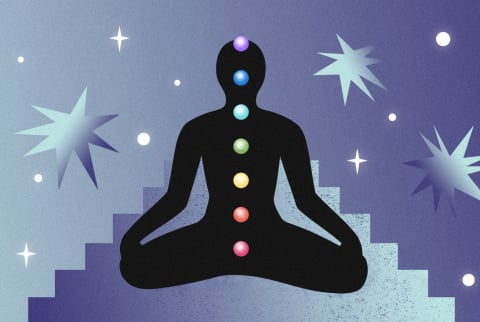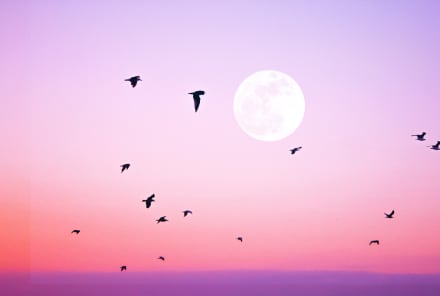Advertisement
Kundalini Awakening: Signs, Causes & How To Cultivate Kundalini Energy


Kundalini, which translates from Sanskrit to "coiled snake," describes the energy that rests, often dormant, coiled at the base of the spine. When it rises or awakens, it can cause a number of experiences and symptoms.
Here's what you need to know about Kundalini awakenings:
Kundalini energy.
Kundalini is considered to be a life-force energy, meaning it's a major source of internal power. We all have it, but not all of us have experienced it as "awakening."
"It's your consciousness," spiritual teacher and author of Transcendence Calling Monique Rebelle puts it. "Everything that you are, you think, you remember, that you can visualize—anything—that's your consciousness," she adds. "That's Kundalini."
She explains that this energy, which is traditionally thought to be feminine (sometimes called Kundalini Shakti), is only able to flow freely when one's chakras are totally clear and open.
"The chakras are like gates to the dimensions of perception," Rebelle says, noting that for many, blocked chakras do not allow Kundalini energy to flow.
What causes a Kundalini awakening?
The truth is, there's no one answer to this question. For some, a Kundalini awakening can happen after years of cultivating a spiritual practice, doing Kundalini yoga, meditating, etc. But just as well, it can happen spontaneously, with no prior training.
As Kundalini yoga teacher Krishna Kaur explains to mbg, "The Kundalini rising is an automatic thing that happens—and it can happen under any type of spiritual discipline, any style of yoga."
So, it's not something you should necessarily seek out.
Through the practice of enriching your spirituality and inner world, you may eventually become so neutral and so balanced "that you know you've reached a place of total awakened-ness," Kaur notes, adding that she does not teach people to raise their Kundalini energy with an awakening as the goal—and doesn't think people should attempt it.
Signs you're going through one:
- You have a feeling of freedom, from the ego and from the material realm.
- You feel euphoric in the moment and have a sense of resounding peace.
- You transcend the dual nature of the mind and are able to see that we consciously create our reality.
- You feel love and compassion for all that is and recognize yourself as an intrinsic part of all.
- Your mind is noticeably more still, with a new ability to focus on one thought at a time.
- Your mind is able to witness, observe, and discern (thanks to an open crown chakra).
- Old problems and even past trauma do not have the same effect on you anymore. You remember them, but they no longer bother you.
- You might feel pleasurable physical sensations—like a full-body orgasm but one that is more sensual than sexual.
- You have profound new insights into your life or even past lives.
- You have a newfound strength and clarity that allows you to make positive changes in your life without fear.
- Your creativity surges.
- You have a significant increase in empathy.
- Your body may shake. (This can happen if Kundalini is rising but your chakras are not clear, so the energy isn't able to flow.)
- You feel heat in the spine. (This would, again, be an instance of rising Kundalini energy not quite flowing properly, Rebelle says.)
- You have trouble sleeping. (This is another example of what can happen when Kundalini rises in a body with chakras that are not fully clear.)
Pros & cons of a Kundalini awakening.
- A Kundalini awakening can bring you to self-realization, or as Rebelle explains, "self-realization of the soul as an immortal being."
- You may reach a state of bliss and resounding love.
- You may have a quiet mind. "Any problem can be solved with a clear mind, a mind that isn't congested with lingering structures and all that's stopping us from growing—stuck in who we think we are," Rebelle adds.
- You may experience spiritual enlightenment, "which is a connection with all there is and an understanding that we are continually creators of all there is, all the time," Rebelle notes.
- You may have increased creativity and compassion.
- It is possible to raise Kundalini energy by accident and/or without being ready. "Most of us have chakras that are very congested," Rebelle notes, adding that people should be careful of trying to go about waking up their Kundalini. Kaur echoes this thought: "You can raise your Kundalini by accident, but it doesn't raise your consciousness."
- Kundalini awakenings will be different for everyone, and some say it can feel like a bad drug trip or psychosis.
- In a body that does not have clear chakras, unpleasant physical symptoms can also arise, like body spasms and feeling hot.
Kundalini awakening vs. spiritual awakening.
As Rebelle explains, the difference between a Kundalini awakening and a spiritual awakening can be difficult to discern in the moment.
It's not always possible to know if our Kundalini energy is rising or we're going through a different kind of spiritual experience.
"We can have the instances of Kundalini awakening, and then we can also have instances of upper chakras opening," Rebelle says. "They don't have to be related but can be."
According to her, upper chakras opening can manifest in sudden realizations, visions, insights, connecting with spirits, psychic insights, experiences of a sudden feeling of love out of nowhere, and more—but that doesn't necessarily mean it's Kundalini.
To put it simply, a Kundalini awakening can be classified as a type of spiritual awakening, but a spiritual awakening isn't always related to Kundalini.
If you're unsure what you're experiencing, the best method would be to seek the guidance of a spiritual teacher or guide. Rebelle notes this is one thing she addresses with her students who are trying to figure out if they've experienced Kundalini rising or another type of spiritual experience.
Practices to cultivate your Kundalini energy.
Kaur makes one thing very clear: attempting to "achieve" a Kundalini awakening should not be the goal. The "goal," so to speak, should merely be to become a whole, self-actualized person. If your Kundalini energy rises, it rises—but if not, you're still doing yourself a service by cultivating your spirituality.
Rebelle echoes this sentiment, explaining, "If people try to awaken Kundalini on its own, it's very often not a good idea. For 99.9% of us, when we try to awaken Kundalini by itself without training and cultivating the upper chakras, often people feel the stiffening of the body, they feel heat in their back, in the spine, they have all kinds of physical reactions."
This happens when Kundalini is awakening "but it's not going through the chakras; it's just all over the place," she adds.
All that said, the following are some ways you can cultivate your spirituality and consciousness more generally:
- Work with and train the second and third chakras: Rebelle notes these two chakras (the sacral and the solar plexus) are based in logic and emotion. They keep us grounded in the material and need to be unblocked so we can enter our heart space, where we begin to transcend the material.
- Cultivate the upper chakras: Rebelle explains that unblocking these chakras (the heart, the throat, the third eye, and the crown chakras) can be difficult, and it's best to focus on simply cultivating them. Often, the "goal" of wanting or seeking something can make it that much more out of reach.
- Meditate: "Surrendering the mind, quieting the mind, and practicing focusing the mind is very important," Rebelle says. This will allow you to get to a place of mental stillness, where you have mental clarity, and there is more internal flow.
- Do yoga: Of course, Kundalini yoga would likely be the most obvious choice if you have Kundalini energy in mind, but any form of yoga can help you on your spiritual journey.
- Cultivate love: Feeling love is important, but Rebelle notes giving love ultimately helps us cultivate more of it. To do so, try loving-kindness meditation.
- Work with sound: Sound is closely related to the throat chakra. Rebelle explains that vibration, sound healing, music, and even chanting mantras are all ways to work with the power of sound.
- Try tantra: Many people claim to have had a Kundalini rising experience through tantra, whether that's tantra yoga or tantric sex. Tantra is all about the weaving of masculine and feminine energy.
The bottom line.
Seeking is often the biggest roadblock on any spiritual journey. While Kundalini awakenings can sound mystical and amazing, they can also be overwhelming if you're not prepared. So if you're itching for an experience, try to let go of that desire. Focus instead on the act of enriching your life, with no goal in mind. If you do that, as Kaur says, "you're going to be a winner anyway."
Watch Next
Enjoy some of our favorite clips from classes
Enjoy some of our favorite clips from classes
What Is Meditation?
Mindfulness/Spirituality | Light Watkins
Box Breathing
Mindfulness/Spirituality | Gwen Dittmar
What Breathwork Can Address
Mindfulness/Spirituality | Gwen Dittmar
The 8 Limbs of Yoga - What is Asana?
Yoga | Caley Alyssa
Two Standing Postures to Open Up Tight Hips
Yoga | Caley Alyssa
How Plants Can Optimize Athletic Performance
Nutrition | Rich Roll
What to Eat Before a Workout
Nutrition | Rich Roll
How Ayurveda Helps Us Navigate Modern Life
Nutrition | Sahara Rose
Messages About Love & Relationships
Love & Relationships | Esther Perel
Love Languages
Love & Relationships | Esther Perel

















